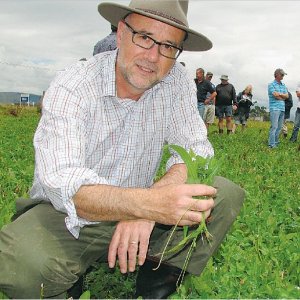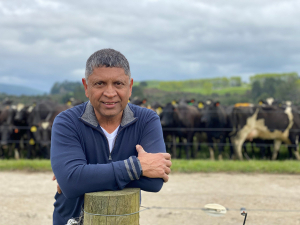It's the fourth and final field day of a pasture project that has an unusual, if not unique, element to it.
The ag scientists are explaining to the farmers the nature of the mixed herb and clover pasture trials to fatten lambs faster. Meanwhile a second group of researchers stand back, observing the interaction and making notes.
It seems highly unusual to have social scientists and ag scientists working together, but in this case it makes perfect sense. This is as much about the communication of science as it is the actual production science.
The idea for the study came when head of the Institute of Natural Resources and Professor of Pasture Science at Massey Professor Peter Kemp was talking to his wife, College of Education researcher, Alison Sewell, about the challenges of getting farmers to learn more about research on the value of herb and clover pastures. One thing led to another and finally a joint trial was initiated. The project is funded by the National Research Centre for Growth and Development (NRCGD) and Massey geneticist, Professor Hugh Blair who's co-ordinating the project, says the aim is to study how farmers learn about new scientific developments.
Nineteen farmers from the lower half of the North Island have been participating in what's been called 'the farmer learning trial'. Hugh Blair says the idea is to find out how the fundamental science being carried out at Massey can ultimately be translated into business so there are more jobs and more tax for the Government.
"We've got to work out how to get our research out into the farming community. The fundamental question we are asking is 'how do the farmers want the information put in front of them so that we can best help them change behaviour at their farm?'. If our research doesn't have an impact on the farm and doesn't result in more exports then we haven't done a good day's work," he says.
Blair says what's different about this study is they are asking the farmers how they want to get the information with the aim of coming up with a model that will help other scientists transfer science and knowledge to farmers.
Kemp, says it all began when a trial was started to see if the herb and clover pasture mixes would work all year round.
"We'd done a lot of previous experiments of about two or three months long but of course farmers want to know how will this work on the farm all the time. So we decided to run a trial for several years on finishing lambs on a continuous basis like a farm and finding how well the farmers adopted these ideas," he explains.
Farmers who were either using the herbs already, or had declared an interest to do so, were invited to take part.
"They weren't selected randomly. They were selected through a network of farmers we knew and some suggested others and that kind of thing. In the longer term I think we'd like to see these farmers take this message out to other farmers, perhaps through field days and things on their own farms."
Kemp's fellow Massey professor, Steve Morris, has been following the weight gains of the lambs on the various plots.
"Initially the plantain and red clover mix has been in front and then as summer has gone on, the chicory and red and white clover has been where the animals have done the best liveweight gain."
In mid February, lambs on chicory, plantain, red and white clover were growing at just under 300 grams a day.
"The ones on the plantain red and white clover have only been doing 218 grams which is still very good, but the ones on the ryegrass with white clover have dropped back to 114 grams."
That's typical for this time of year, it being very difficult to get more than 120 or 130 grams a day on straight ryegrass pasture, although with clover you might get to 150 grams per day, he notes.
The herb pasture mix has been dubbed the 'turbo mix' after the local rugby team. With the trial still in its first year, Morris and his colleagues want to see how the mixtures perform over three years and, in particular, to check for persistency.
The trial is also looking at how much meat per hectare is produced on the pastures, with batches of lambs being killed to measure this.
Morris says an issue that farmers will need to consider is just how much of their land would they convert to such mixes and what class of stock they would carry, and when.
"In the spring the best class of animal is to have a ewe with triplets. In the autumn it might be ewe hoggets."
Having the farmers involved in the project is proving of great value.
"This has changed some of our decisions because we hadn't thought about everything. It's great having scientists and farmers working together. But it is time consuming."
Sewell's work at the College of Education, Palmerston North, normally deals with children and student learning, so farmers are a bit outside the square, she admits.
She and other social scientists observe the interaction between the farmers and pasture science team and talk to the farmers after every session to find out their views on the project.
"The main things they are telling us is the relationships they are having with the science teams and the trust they have. They like the hard data and have great respect for the science team and ongoing nature of the work."
Another important piece of feedback from farmers is that they feel that they can share their expertise with the scientists.
"While the science team has expertise, the farmers are now trying these ideas and are coming back with their expertise. There is some really good dialogue going on between the farmers and science team on a whole range of topics."
The social scientists also act as a sort of a go-between with the farmers and production scientists, picking up information from the farmers and relaying this.
"For example, the farmers have said after every session they want a one page summary which has been done," she says.
Massey's Brennon Woods is also part of the social scientist team observing the interaction. He's interviewed all the farmers on their experiences of the project, with particular emphasis on how the pilot project could eventually be scaled up to a larger project on technology transfer.
Woods says there's a lot of interest in what Massey is doing in this project, as it mimics 'extension' work which was common in the 1970s.
"There's now a real gap in this area and this pilot study is a move in the right direction."
One of the things that has struck him is the huge expertise of the farmers and the contribution they can make to science through their practical knowledge and also the fact that they start to 'own' the science and can pass it on to others.
But the ultimate success of the project hinges on engaging more farmers. As Hugh Blair puts it, "We have 19 on board – we only have 13,987 to go."
How remains to be seen, but new information hubs or networks are possibilities.
Kemp says while just four sessions with farmers were scheduled for the pilot project, it is planned to keep the farmer group together in some form into the future to gain further insight into the best means of technology transfer.











